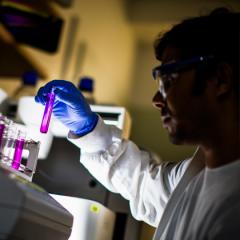Since 2004, the Australian Institute for Bioengineering and Nanotechnology (AIBN) has made a name for itself as the place that combines researchers, industry and government to solve the world’s biggest problems.
Two decades on and the ideas and infrastructure that helped forge the AIBN have evolved to dynamically address emerging challenges for society.
With more than 500 researchers - and housing Australia’s biggest network of National Collaborative Research Infrastructure (NCRIS) facilities – in 2025 the AIBN will mark its 20th anniversary as a research leader and celebrate its role as an incubator for industry collaboration across the fields of personalised medicine, advanced biomanufacturing and materials science.
As we prepare to enter this landmark year, let us look back on the most recent successes that have brought us here.
From pioneering mRNA and vaccine technology to renewable energy solutions, future foods and fuels, and medical solutions that are both targeted and personalised, 2024 was a huge year for the institute and its people.
Here are some of our biggest moments.
New hubs highlight industry buy-in
At the AIBN, working hand in glove with industry to solve some of society’s biggest challenges is what drives us. Research partnerships with Industry are responsible for 40 per cent of total AIBN funding.
The strength of our industry links are best demonstrated through our expanding collaborative platforms, and the launch of two new facilities designed to meet the needs arising from emerging industry trends.
In May we cemented ourselves as pioneers in the precision nanomedicine space with the opening of the Australian Research Council (ARC) hub for Advanced Manufacture of Targeted Radiopharmaceuticals (AMTAR), providing a new platform for biotechs to create the next generation of highly accurate cancer drugs.
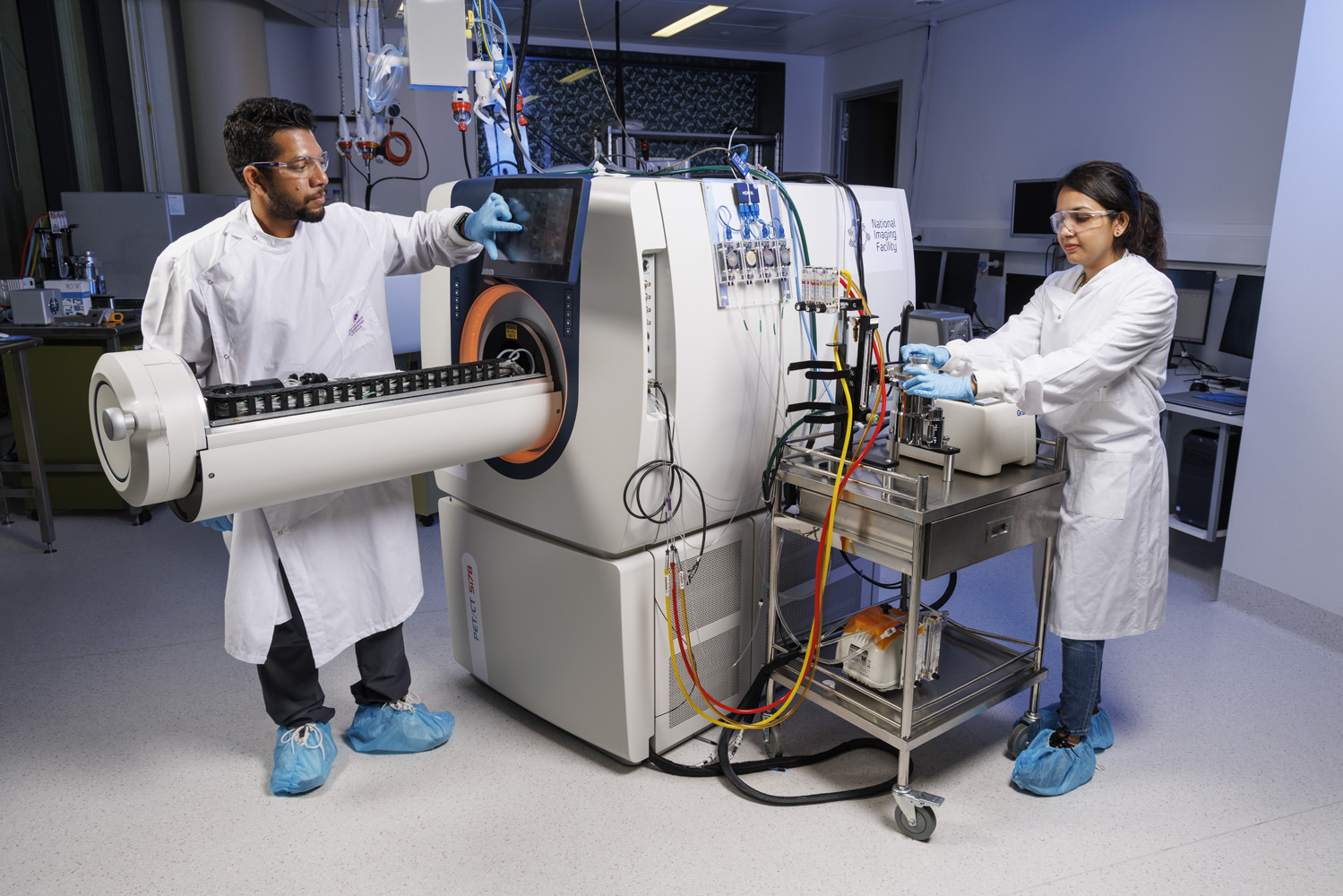
Created through a $5 million ARC grant and more than $10 million in industry co-contributions, the AMTAR hub is supported by collaborators across the radiopharmaceutical supply chain.
Radiopharmaceuticals are an emerging group of drugs designed to localise more efficiently at the site of disease and spare the body from the harsh effects of cancer treatment.
Hub leader and AIBN director of research Professor Kris Thurecht says radiopharmaceuticals already represent a multi-billion-dollar industry that will be integral to modern healthcare.
“Through AMTAR we have an opportunity to position Australia as a global leader in this field.”
Just a couple of months after the launch of AMTAR we were again preparing for expansion of our commercial engagement – specifically our ability to helping the world’s biggest businesses transition to net zero.
Funded by government, industry and UQ, our new $60 million Biosustainability Hub is now online and helping companies transform their production practices to create carbon neutral, economically viable products and materials.
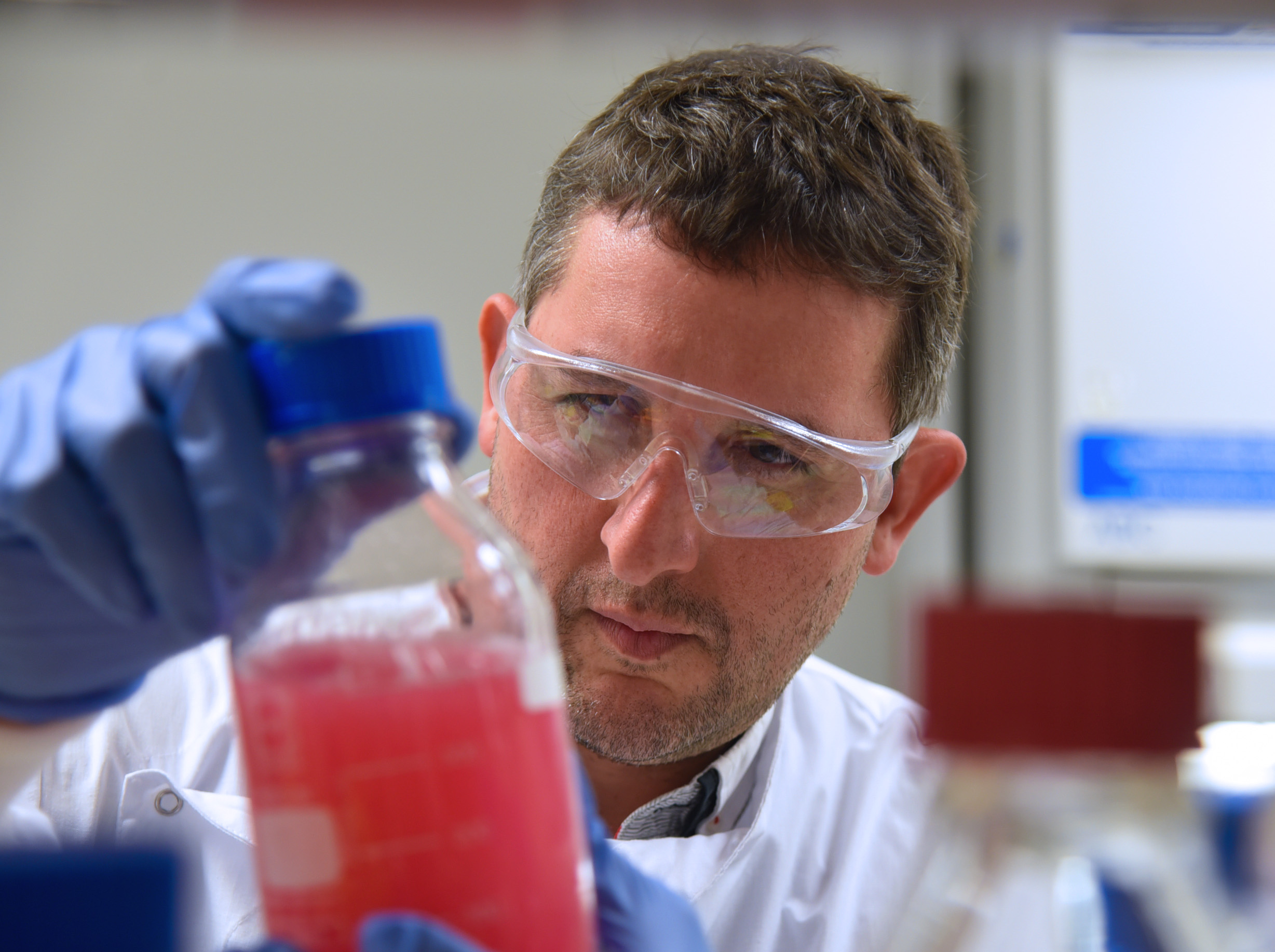
Hub director, Professor Esteban Marcellin, says the facility is the first of its kind in Australia and will become the home of translational biomanufacturing, with industry partnerships already underway, across sustainable aviation, new products, mineral recovery and future ingredients.
“This is an exciting opportunity to model a new way of working with industry leaders, not only for society, but also to create economically viable solutions and opportunities for our partners that will help them transition their production practices,” Professor Marcellin said.
A huge year for grants and funding
AIBN researchers had an unprecedented year for competitive grants, completing 236 applications across 92 different funding schemes.
Keeping with our commitment to collaboration and entrepreneurship, industry-adjacent schemes proved to be a big source of success.
The state government’s Advance Queensland Industry Research Fellowships and Industry Research Projects, as well as the Australian Research Council Industry Fellowships and Linkage Programs are among the programs that are connecting us with business to fix the big problems in health, energy, food, and fuels.
Elsewhere, our National Health and Medical Research Council (NHMRC) Investigator grant success was well above the national rate at 25 percent..
In 2024 the AIBN also celebrated the award of the University of Queensland’s first ever ARC Industry Laureate, Professor Lianzhou Wang.
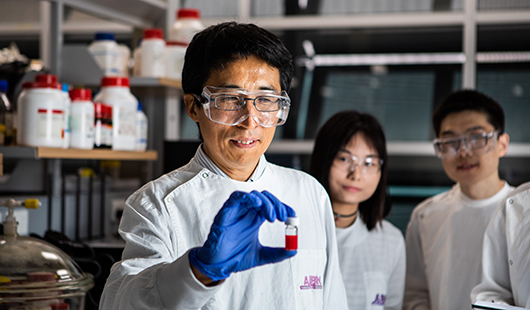
Professor Wang – who has a joint appointment with the UQ School of Chemical Engineering – is a pioneer in the clean energy sector and renowned for his work in new functional materials for solar energy conversion and energy storage systems.
He will use his $3.6 million Laureate Fellowship in collaboration with industry partners Pure Battery Technologies and Lithium Australia to help position our nation as a leading supplier of superior batteries for electric vehicles.
Another AIBN research leader, Dr Li Li, also gained significant ARC backing, obtaining an ARC Mid-Career Industry Fellowship to help local mushroom grower Kenon Corporation transform agricultural waste into high-quality soil products for mushroom cultivation and crop growth.
AIBN is also home to another four ARC Laureates, four ARC Future Fellows, two NHMRC Leadership and twelve NHMRC emerging leadership Follows, six Advance Queensland Industry Research Fellows, and nine ARC Discovery Early Career Researcher Award recipients.
Making new mRNA vaccines for cancer
The AIBN’s BASE Facility is already renowned as the nation’s leading producer of mRNA for research and pilot studies since its launch in 2021 – and this year the team added individually designed cancer vaccines to its repertoire.
Backed by a $3.3 million grant from the Medical Research Future Fund’s (MRFF) National Critical Research Infrastructure program, the new BASE Facility cancer vaccine hub will bring together the equipment and expertise to enable the design, manufacture and delivery of new mRNA cancer vaccines.
Dr Seth Cheetham, Deputy Director of AIBN’s BASE facility, said the new hub will provide the local research community with vaccines that match the specific treatment needs of each patient –transforming how we address this serious disease.
BASE has provided academic and industry partners with more than 300 experimental grade vaccines.
The 5-year cancer vaccine lab program will also bring together partner investigators from UQ, QIMR Berghofer, Mater Research, Garvan Institute of Medical Research and the Queensland Children’s Hospital.
Confirming QLD as a renewable energy powerhouse
Adjunct Associate Professor Jens Noack believes redox flow batteries could be the key that unlocks the global renewable energy transition. And he says the conditions are ideal for Queensland – and the AIBN - to lead the way.
Jens is an energy storage expert with German R&D giant Fraunhofer ICT – the company that last year signed a landmark Memorandum of Understanding with The University of Queensland to work collaboratively on new battery solutions.
During a visit to the AIBN this year Jens teamed up with AIBN experts such as Professor Lianzhou Wang and Associate Professor Bin Luo to begin their work perfecting flow battery technology while building a business case that industry and government can get behind.
Cheaper to make, longer lasting, and easily scalable for industrial use, flow batteries are widely seen as the missing piece that will allow societies to embrace large-scale solar and wind generation.
Using Queensland as a proving ground, Jens and the AIBN are working towards a future where researchers, government, and industry unite to harness the state’s ample mineral resources - and suitability for wind and solar infrastructure – to show the world how flow batteries can be industrialised for utility-scale storage purposes.
Testing spider venom drugs on tiny brains
Tiny, synthetic brains produced by AIBN Professor Ernst Wolvetang are being used to prove the effectiveness of epilepsy drugs made from spider venom.
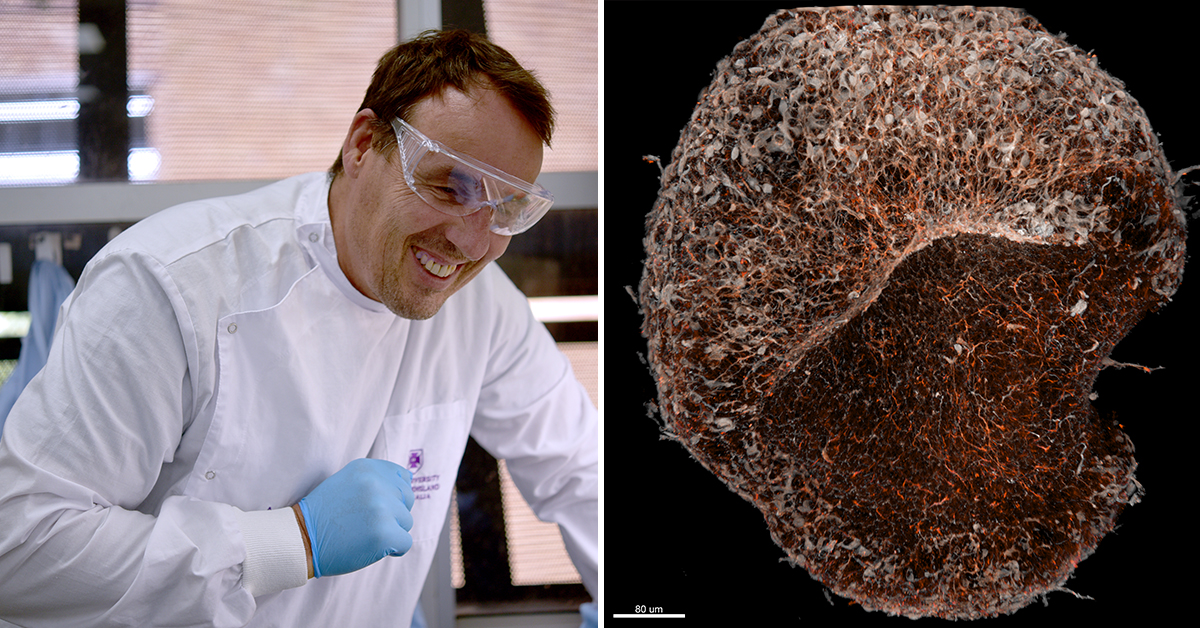
Backed by a $4.1 million grant from the Medical Research Future Fund (MRFF), UQ’s foremost experts in stem cell technology and venom-based drug discovery began making tiny organ replicas – known as organoids – to prove the safety and efficacy of new anti-seizure treatments.
The brain organoids from Professor Wolvetang’s lab will be used to test novel anti-seizure spider venom peptides developed by Professor Glenn King from UQ’s Institute for Molecular Bioscience (IMB).
The safety of Professor King’s venom peptides will also be assessed in patient-derived heart cells designed by Associate Professor Nathan Palpant, also from IMB.
Professor Wolvetang says the overall MRFF project is an exercise in building the case for human stem cell-derived organoids as a tool for developing precision therapeutic approaches.
“If we are successful in showing that our organoid models are truly as predictive and as powerful as we think they are, it will be another step towards fostering regulatory change in the Therapeutic Goods Administration (TGA) and would further establish that patient specific organoids are a powerful tool that can speed up the process towards new treatments”.
This was just one piece of pioneering organoid research to emerge from the Wolvetang team in 2024.
Senior Research Fellow Dr Mohammed Shaker also produced a first of its kind brain organoid to help identify therapies that reduce the impact of COVID-19 on people with Down syndrome.
Dr Giovanni Pietrogrande, meanwhile, made a significant step towards enabling women with epilepsy safer access to a common and highly effective anti-seizure medication, identifying drug that could nullify the dangerous side effects of sodium valproate to children in utero.
Harnessing nanoparticles to tackle heart disease and breast cancer
The AIBN’s Associate Professor Joy Wolfram in 2024 was one of two UQ researchers to secure a Heart Foundation Future Leader Fellowship and plans to use her $561,600 prize to develop a new range of therapeutics that reduce heart inflammation and tissue damage following open-heart surgery.
Associate Professor Wolfram is an AIBN research leader who is jointly affiliated with UQ's School of Chemical Engineering, and specialises in the field of extracellular vesicles – the tiny internal packages our body uses for communication.
Through her Heart Foundation fellowship, she plans to take extracellular vesicles from healthy individuals and engineer them as new treatments to help those who’ve undergone open-heart surgery.
“The long-term goal of this work is to save lives and enhance quality of life for patients.”
The fellowship caps a big 2024 for Associate Professor Wolfram, who in April secured a $590,452 grant from the National Breast Cancer Foundation to explore how extracellular vesicles can be used to fight a particularly deadly type of breast cancer.
Triple-negative breast cancer is aggressive, harder to treat and - for the 2500 Australian women who are diagnosed each year – the disease is more likely to spread to other organs and result in death.
These two projects demonstrate the passion and dedication with which Associate Professor Wolfram approaches her work, something the Australian Institute of Policy and Science (AIPS) also saw when they named her Queensland's Young Tall Poppy of the Year.
The AIPS Young Tall Poppy Awards are a national initiative held to recognise excellence in research and enthusiasm for communicating science beyond the walls of the laboratory.
AIBN had three finalists in the top 10 of the QLD Tall Poppy Awards this year with Dr Lena Oestreich and Dr Nasim Amiralian also nominated alongside Associate Professor Wolfram.
As QLD’s Young Tall Poppy of the year, Associate Professor Wolfram will have a new platform to showcase her research and inspire the next generation of scientists coming through AIBN.
PFAS as a renewable energy solution?
AIBN research leader Dr Cheng Zhang was back in the news in October with new technology that can remove harmful ‘forever chemicals’ from water so they can be used in renewable batteries.
Dr Zhang and his team made a filter which quickly and cleanly captures per- and polyfluoroalkyl substances (PFAS).
The filter contains a patented sorbent solution that uses an ion-exchange technique to isolate and remove the PFAS particles as the water passes through it.
Dr Zhang said fluorine-based materials can be harvested from the filter and he’s working on using them to improve clean energy technology, specifically rechargeable batteries.
Having successfully tested a prototype of the PFAS filter in a laboratory, Dr Zhang and Professor Jianhua Guo from UQ’s Australian Centre for Water and Environmental Biotechnology will soon commence pilot testing in Brisbane and the US with $1 million backing from the Advance Queensland Industry Research Projects program.
Testing is being planned for a range of sites including the Luggage Point Sewage Treatment Plant with water management company GHD, project management firm OCTA, and the Queensland Department of Environment, Science and Innovation.
In the second year of the project, an additional pilot site will be established to scale up testing.
A new approach to treating MND
Backed by $1.3 million in funding from the FightMND Foundation, Associate Professor Shyuan Ngo has kicked off a new project to explore how extracellular vesicles (EVs) – in our skeletal muscles influence the onset and progression of MND.

While MND is traditionally considered a condition of the brain or spinal cord, Associate Professor Ngo said it was increasingly clear that other factors outside of the central nervous system also play a role in its progression.
Her FightMND project will seek to confirm skeletal muscle as another factor influencing this incurable neurodegenerative condition, opening a pathway to newmuscle-directed treatments and add-on therapies to drugs that protect neurons.
Associate Professor Ngo said examining the condition from new angles – including the impact of cell-to-cell communication within muscles - would help uncover disease drivers that could be targeted with drugs and therapies.
The muscle EV project is one of three led by Associate Professor Ngo to win funding in the latest round of FightMND grants.
A total eight UQ investigators received FightMND backing for research and care initiatives for people living with MND.


